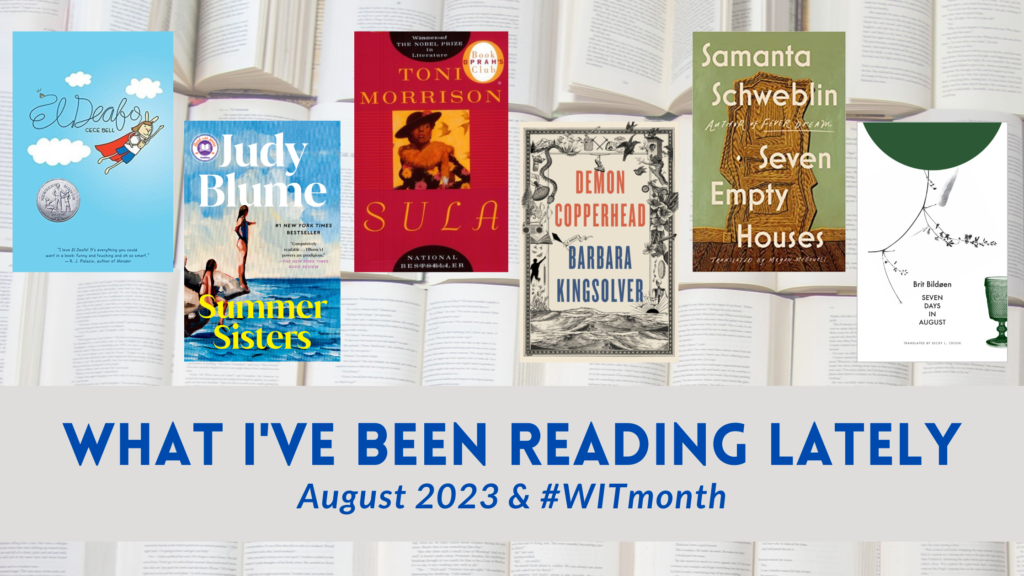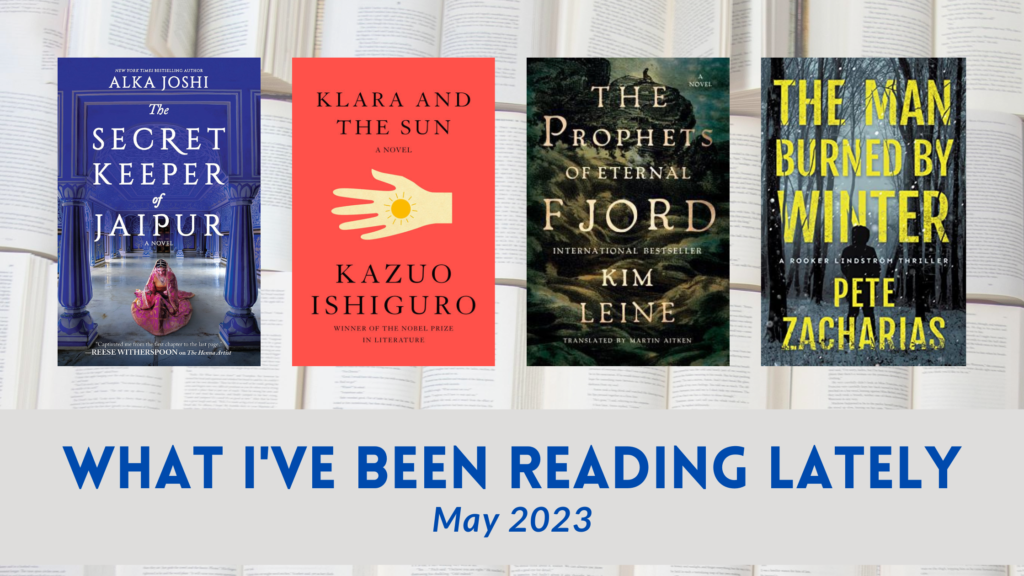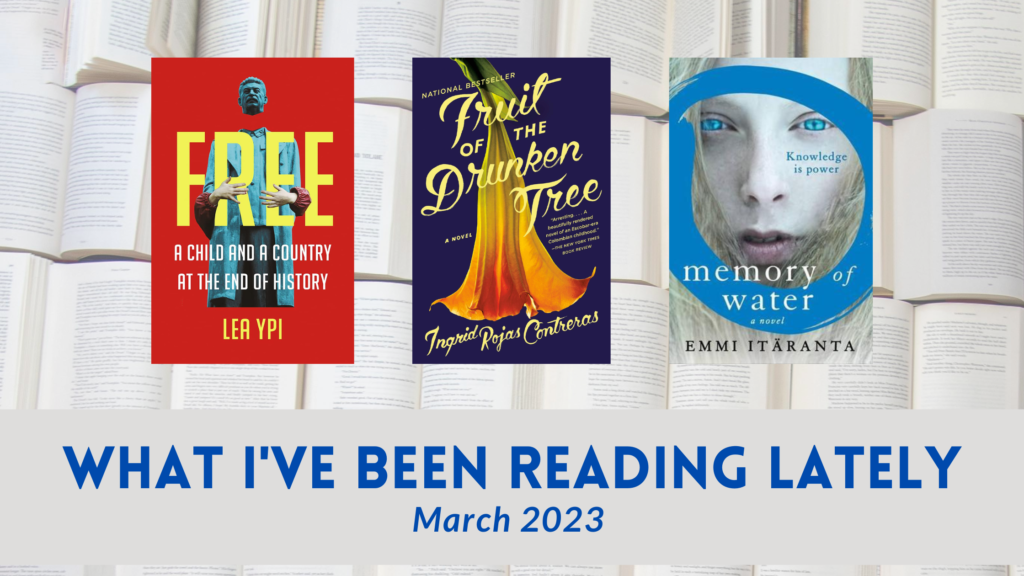The 2023 reading year was a good one, so many different reading experiences. I didn’t quite check off all my goals as planned, but new and exciting reading opportunities came up along the way. Continue reading
Tag Archives: #NordicLitReadingChallenge
What I’ve Been Reading Lately (September 2023)
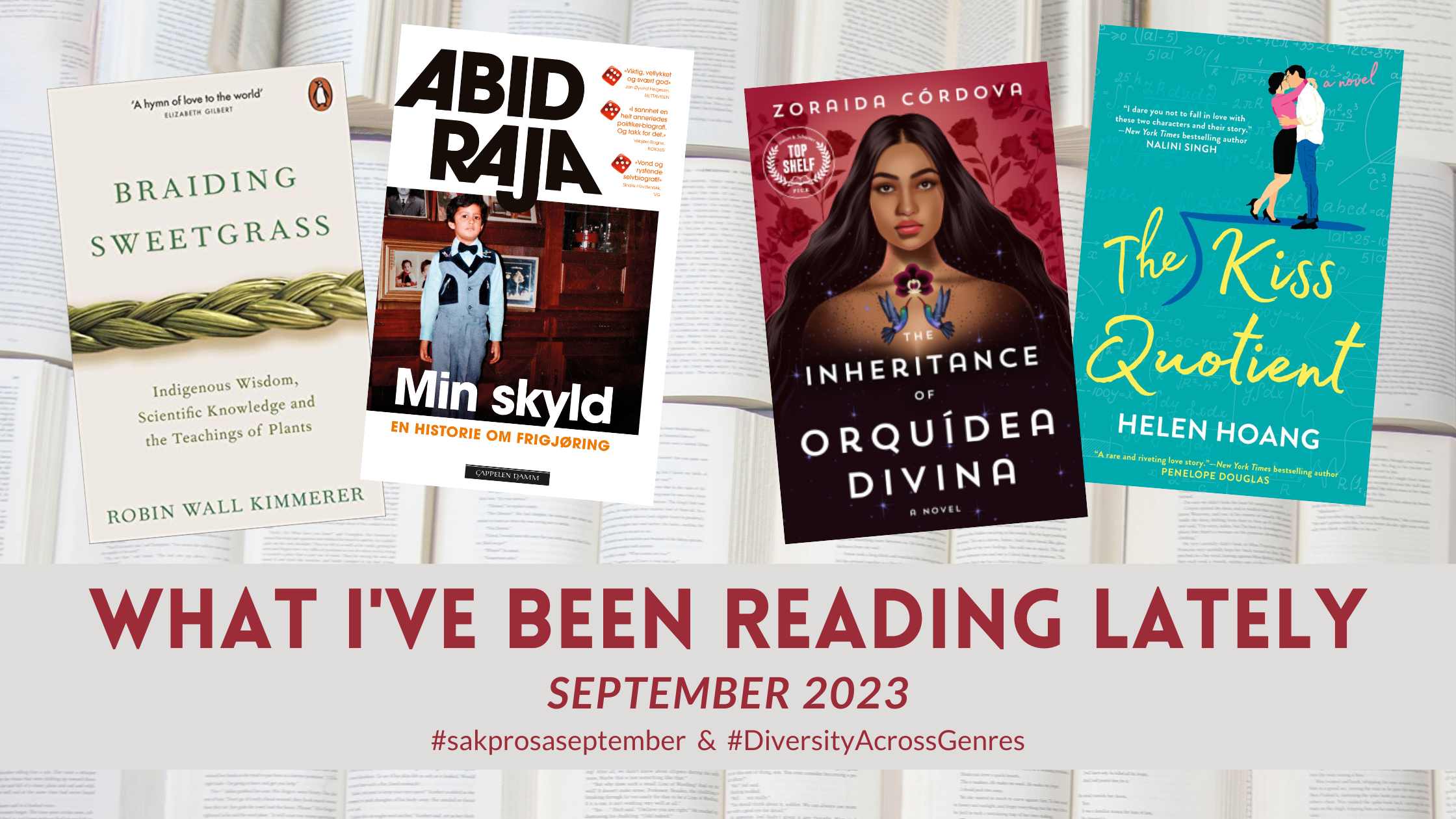
In September, my main focus was nonfiction, but I threw in some fun fiction genres outside my comfort zone as well. Last year, I was introduced to a new reading challenge, #sakprosaseptember, a nonfiction reading challenge hosted by Norwegian bookstagrammer readygoread during the month of September (“sakprosa” means nonfiction in Norwegian). I didn’t used to read a lot of nonfiction, but in the last couple of years, I’ve noticed I’ve been drawn to it more and more and welcome the opportunity to read more of it. So once again I participated in #sakprosaseptember (running through October 15) with its various nonfiction reading prompts. Continue reading
What I’ve Been Reading Lately & #WITmonth (August 2023)
Another big reading month for me in which the summer book bingo happening at work continued to be the prime motivating factor. Needless to say, I’ve got some catching up to do this fall for other reading challenges!
August was Women in Translation Month. I was able to read two books by women in translation, but they were not ones on my initial TBR list. I had pulled out a stack of three Scandinavian books – a Norwegian one, a Swedish one, and a Danish one – but none of them were the ones I ended up reading. I did begin the Norwegian one but had to set it aside because it wasn’t working for me at the time. Instead I picked up a collection of short stories by an Argentinian author which hit the spot. And then I moved on to a different Norwegian author with a book that unexpectedly met a prompt for my 2023 Nordic Literature Reading Challenge. Both of those were great reads, and I look forward to revisiting the original stack this fall. Continue reading
What I’ve Been Reading Lately (May 2023)
Last month was a very mixed month of reading on a variety of fronts — genres, settings, and enjoyment. Luckily, I enjoyed the second in a series as much as the first; but unfortunately, I had to quit a multiple award winning book. Continue reading
Nordic Lit Reading Challenge 2023: My Top Picks for Nordic Council Literature Prize Winners
The 2023 Nordic Literature Reading Challenge is underway, and one of the prompts for the challenge is to read a winner of the Nordic Council Literature Prize. Awarded since 1962 to a work of fiction written in one of the Nordic languages, the mission of the Nordic Council Literature Prize is to “generate interest in the literature and language of neighbouring countries, and in the Nordic cultural community”.
This is a somewhat tricky prompt because not all of the winners have English translations, and of those that do, they aren’t always readily available. Of course you can read a winner in the original language, but here’s a list of winners with English translations in case that’s not possible. In planning my own reading for this year’s challenge, I picked out the following books from each of the Nordic countries to consider for this prompt.
DENMARK – The Prophets of Eternal Fjord: A Novel by Kim Leine, translated from the Danish by Martin Aitken (novel, 500+ pages)
About the winning piece from the Nordic Council (2013):
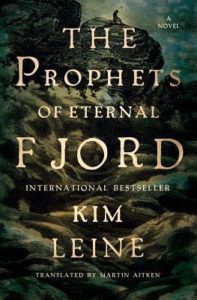 “Kim Leine’s great epic, ‘Profeterne i Evighedsfjorden’, is the story of the Danish priest Morten Falck who travels to Greenland at the end of the 1700s. Through this unfolds the tale of Danish colonisation as a completely crazy and meaningless project. The Danish officials try to keep hold of power and customs but are plagued by homesickness and resignation. Grief and anger smoulders amongst the Greenlanders, and some of them seize Christianity and the European ideas of freedom as an inspiration for rebellion against colonial power. But as well as being a critical, historical novel that reminds us of Denmark’s problematic past as a colonial power, the book is also a depiction of dirt as mankind’s basic element.”
“Kim Leine’s great epic, ‘Profeterne i Evighedsfjorden’, is the story of the Danish priest Morten Falck who travels to Greenland at the end of the 1700s. Through this unfolds the tale of Danish colonisation as a completely crazy and meaningless project. The Danish officials try to keep hold of power and customs but are plagued by homesickness and resignation. Grief and anger smoulders amongst the Greenlanders, and some of them seize Christianity and the European ideas of freedom as an inspiration for rebellion against colonial power. But as well as being a critical, historical novel that reminds us of Denmark’s problematic past as a colonial power, the book is also a depiction of dirt as mankind’s basic element.”
Why I’m considering it: I’m intrigued by this selection due to the time and place of the setting, both of which are new to me, and I have no familiarity with this story of Denmark’s past. On top of that, it’s a multiple prize-winning book. Besides winning the Nordic Council Literature Prize in 2013, it won the Danish literature prize De Gyldne Laurbær in 2012. It also made the shortlist for the Dublin Literature Award in 2017. This book would be an option for two of the prompts for the Nordic Lit Reading Challenge!
FINLAND – Purge: A Novel by Sofi Oksanen, translated from the Finnish by Lola Rogers (novel, 417 pages)
About the winning piece from the Nordic Council (2010):
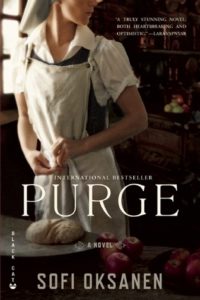 “Her [Sofi Oksanen’s] third novel, Purge, is about the Soviet occupation of Estonia and its consequences. Unfortunately, it is also very much of current interest with its stories about human trafficking around the Baltic. The book’s two time levels are 1992 – one year after Estonia won its independence – and the 1940s – when tens of thousands of Estonians were deported to Siberia and agriculture was collectivised. On a summer morning in 1992, old Aliide Truu finds an exhausted and confused young woman in her vegetable garden. This Zara has been tricked away from her home in Vladivostok to work as a sex worker in Berlin. On the way to Tallinn where she was supposed to start selling her body to Finnish sex tourists, she manages to escape.”
“Her [Sofi Oksanen’s] third novel, Purge, is about the Soviet occupation of Estonia and its consequences. Unfortunately, it is also very much of current interest with its stories about human trafficking around the Baltic. The book’s two time levels are 1992 – one year after Estonia won its independence – and the 1940s – when tens of thousands of Estonians were deported to Siberia and agriculture was collectivised. On a summer morning in 1992, old Aliide Truu finds an exhausted and confused young woman in her vegetable garden. This Zara has been tricked away from her home in Vladivostok to work as a sex worker in Berlin. On the way to Tallinn where she was supposed to start selling her body to Finnish sex tourists, she manages to escape.”
Why I’m considering it: Sofi Oksanen is a Finnish author (Finnish father and Estonian mother) who first appeared on my radar for her latest novel Dog Park (2021 in translation by Owen Frederick Witesman). The Soviet occupation of Estonia is a little known topic to me, and I always enjoy a good dual-timeline novel.
ICELAND – The Blue Fox: A Novel by Sjón, translated from the Icelandic by Victoria Cribb (novel, 130 pages)
About the winning piece from the Nordic Council (2005):
 “The Blue Fox is a novel about an Icelandic pastor and a fox hunt. Sjón makes use of the Icelandic folktale to tell his story. One of the principal characters is the pastor Baldur Skuggason. He has an evil, dark side to his character. Another key figure is the strange offspring of a cat and a fox following the story – Sjón’s style has elements of a very unique Icelandic sense of humour. The Blue Fox is a short novel with a few sections. Some pages only consist of a single written line, surrounded by large white surfaces calling to mind the Icelandic expanse. This concreteness can be said to balance on the line between prose and poetry. ‘Skugga-Baldur’ is also a contemporary novel which brings up some of today’s ethical questions. Are the weak, deformed babies with developmental disorders welcome in a world where they could have been discarded already prior to birth?”
“The Blue Fox is a novel about an Icelandic pastor and a fox hunt. Sjón makes use of the Icelandic folktale to tell his story. One of the principal characters is the pastor Baldur Skuggason. He has an evil, dark side to his character. Another key figure is the strange offspring of a cat and a fox following the story – Sjón’s style has elements of a very unique Icelandic sense of humour. The Blue Fox is a short novel with a few sections. Some pages only consist of a single written line, surrounded by large white surfaces calling to mind the Icelandic expanse. This concreteness can be said to balance on the line between prose and poetry. ‘Skugga-Baldur’ is also a contemporary novel which brings up some of today’s ethical questions. Are the weak, deformed babies with developmental disorders welcome in a world where they could have been discarded already prior to birth?”
Why I’m considering it: I’ve been curious about Sjón for a while. Besides writing novels, he’s a poet, screenwriter, and involved in the music scene. In 2016, he was the third writer chosen to contribute to the Future Library project.
NORWAY – The Ice Palace by Tarjei Vesaas, translated from the Norwegian by Elizabeth Rokkan (novel, 144 pages)
About the winning piece from the Nordic Council (1964):
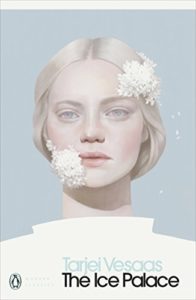 “The Ice Palace is a novel with two 11-year-old girls as the protagonists: extrovert Siss and quiet, introvert Unn. The day after a meeting of the girls at which Unn revealed that she is carrying a dark secret, Unn travels to the ice palace. This is a huge ice formation which builds up at a waterfall in winter-time. As it turns out to be made up of several ice rooms, she walks into the palace. Unn is enthralled by the beauty of the rooms, but in the seventh room she loses her way and cannot find her way out. She freezes to death with Siss’s name on her lips. The novel concludes with the story of Siss’s life and her reaction to Unn’s death. Siss now becomes the quiet and lonely one. She goes into an inner ice palace until she is finally redeemed and can move on into adulthood with a profound insight.”
“The Ice Palace is a novel with two 11-year-old girls as the protagonists: extrovert Siss and quiet, introvert Unn. The day after a meeting of the girls at which Unn revealed that she is carrying a dark secret, Unn travels to the ice palace. This is a huge ice formation which builds up at a waterfall in winter-time. As it turns out to be made up of several ice rooms, she walks into the palace. Unn is enthralled by the beauty of the rooms, but in the seventh room she loses her way and cannot find her way out. She freezes to death with Siss’s name on her lips. The novel concludes with the story of Siss’s life and her reaction to Unn’s death. Siss now becomes the quiet and lonely one. She goes into an inner ice palace until she is finally redeemed and can move on into adulthood with a profound insight.”
Why I’m considering this: I have not read any of Tarjei Vesaas’ works yet, but he is arguably one of Norway’s greatest writers. His authorship spans from 1923 to 1970. He won many awards during his lifetime and was even nominated for the Nobel Prize in Literature 57 times. The Ice Palace and The Birds are his most famous works.
SWEDEN – Blackwater: A Novel by Kerstin Ekman, translated from the Swedish by Joan Tate (novel, 448 pages)
About the winning piece from the Nordic Council (1994):
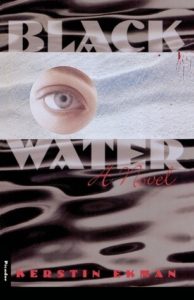 “Blackwater is a detective novel set in the town of Svartvattnet in Norrland. It depicts a woman from Stockholm, who moves in with her boyfriend in the town to work as a teacher in a commune. However, events revolve around a double homicide that remains unsolved and the consequences of this trauma for the people in the town. Kerstin Ekman’s story invites many reading styles; it can be read as a Bildungsroman, as a critical analysis of gender roles, as a mythical story with symbolic elements, but, of course, also simply as a thrilling detective novel.”
“Blackwater is a detective novel set in the town of Svartvattnet in Norrland. It depicts a woman from Stockholm, who moves in with her boyfriend in the town to work as a teacher in a commune. However, events revolve around a double homicide that remains unsolved and the consequences of this trauma for the people in the town. Kerstin Ekman’s story invites many reading styles; it can be read as a Bildungsroman, as a critical analysis of gender roles, as a mythical story with symbolic elements, but, of course, also simply as a thrilling detective novel.”
Why I’m considering it: I read Kerstin Ekman’s God’s Mercy a few years ago. I enjoyed the descriptive setting of rural northern Sweden in the early 1900s. Blackwater also takes place in a remote, northern setting, but in the later part of the 1900s. I’m intrigued by the many ways that Blackwater can be read, but most of all by its crime novel aspect. Besides winning the Nordic Council Literature Prize in 1994, it received the prestigious Swedish August Prize and the Best Swedish Crime Novel Award in 1993.
Which of these would you read first? Are there other Nordic Council Literature Prize winners that you’ve read and would recommend?
Disclaimer: AVikingInLA is a participant in the Amazon Services LLC Associates Program, an affiliate advertising program designed to provide a means for sites to earn advertising fees by advertising and linking to amazon.com.
What I’ve Been Reading Lately (March 2023)
Welcome to another round of “What I’ve Been Reading Lately”. The past month has been a ride around the world with visits to Albania, Colombia, and a dystopian, apocalyptic Scandinavia. Coincidentally, I went straight from reading about one country (Albania) during a turbulent decade to a totally different country on the other side of the world (Colombia) in the same decade, also a turbulent one, which is actually not an uninteresting thing to do. The first was a memoir; the second was a novel based on the author’s own experiences. Both were coming of age stories from the perspective of a young girl and provided interesting insight into a country I was not very familiar with at all. Continue reading
What I’ve Been Reading Lately (February 2023)
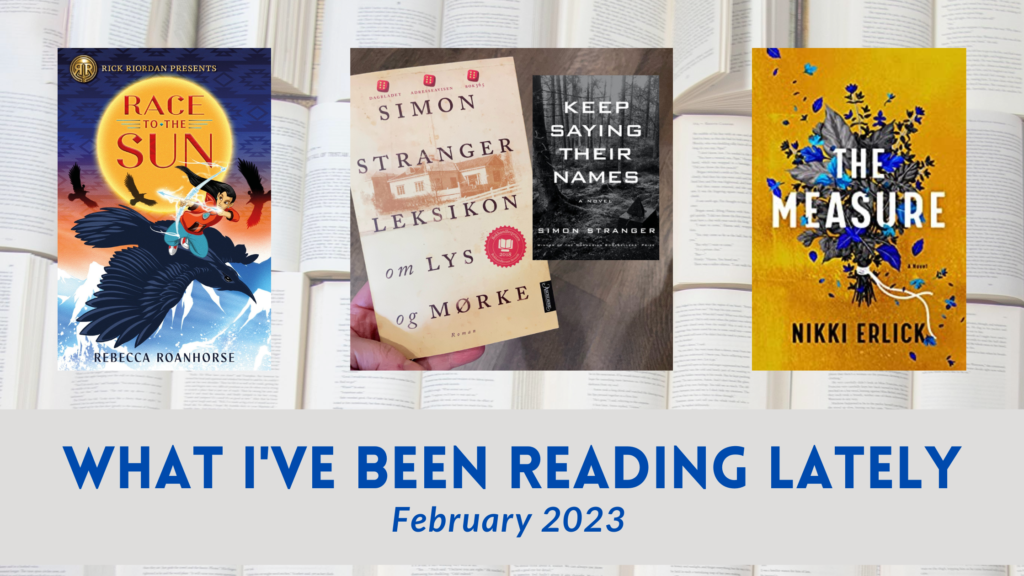
Welcome to another round of “What I’ve Been Reading Lately”. Last month, I finally completed my 2022 Scandinavian Reading Challenge with a book that spanned several decades, and it was a very satisfying way to wrap up the read-through-the-decades challenge. Continue reading


